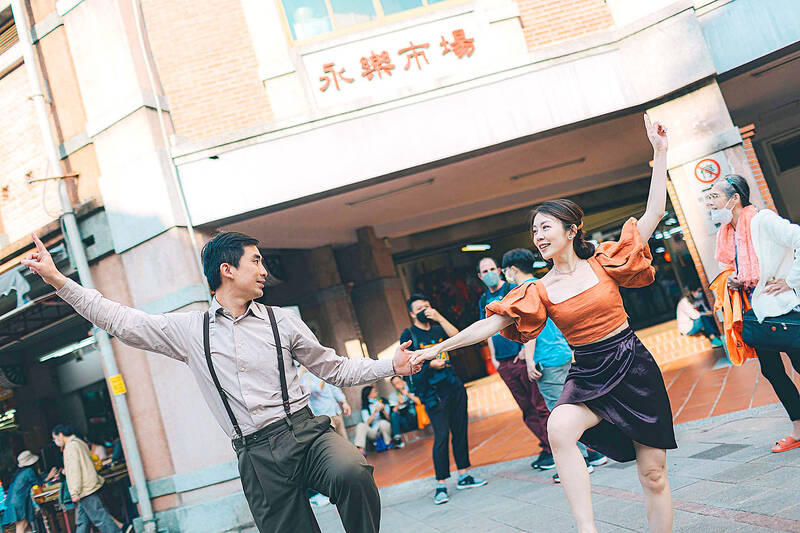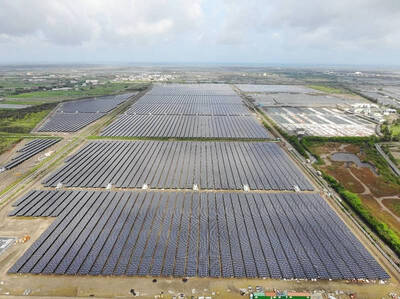Swing your way through old Taipei as the Bubble Pop Lindy Exchange kicks off today for a three-day dance and music extravaganza with an infusion of local culture and history. Visitors will get to take dance lessons, watch professional performances, shop at vintage and food markets, attend seminars and go on cultural tours of historic neighborhoods.
Established swing dance groups from across Taiwan will converge in the capital to share their expertise with attendees and dazzle them with their moves. Live bands such as TPO (踢霹歐), Lady & Knight (女爵騎士), the Flat Fives and the Lin Liang-yu Trio (林亮宇爵士三重奏) will provide the lively soundtrack, and TPO band leader Jim Geddes will offer a seminar about the history of jazz.. Sing Yuen Lim, a dance veteran of 30 years, will share her experiences and rich knowledge of swing dancing.
Popular walking tour group Like It Formosa will take people back in time, visiting sites such as Bopoliao (剝皮寮), Nishi Honganji Temple (西本願寺), Yongle Market (永樂市場) and the Railway Department Park (鐵道部園區).

Photo courtesy of Bubble Pop Lindy Exchange
The main event of each night is the dance party at the Red House Theater, which will rage on until 1:30am. Keep note of the dress codes for each day.
■ Most events are free at the Red House Theater’s north plaza, 174, Zhonghua Rd Sec 1, Taipei City (台北市中華路一段174號). The dance party is on the second floor of the building, admission is NT$1,400 per night and NT$4,500 for three nights
■ Today through Sunday, for full schedule visit www.bubblepop.tw

Photo courtesy of Bubble Pop Lindy Exchange

Photo courtesy of Bubble Pop Lindy Exchange

With one week left until election day, the drama is high in the race for the Chinese Nationalist Party (KMT) chair. The race is still potentially wide open between the three frontrunners. The most accurate poll is done by Apollo Survey & Research Co (艾普羅民調公司), which was conducted a week and a half ago with two-thirds of the respondents party members, who are the only ones eligible to vote. For details on the candidates, check the Oct. 4 edition of this column, “A look at the KMT chair candidates” on page 12. The popular frontrunner was 56-year-old Cheng Li-wun (鄭麗文)

“How China Threatens to Force Taiwan Into a Total Blackout” screamed a Wall Street Journal (WSJ) headline last week, yet another of the endless clickbait examples of the energy threat via blockade that doesn’t exist. Since the headline is recycled, I will recycle the rebuttal: once industrial power demand collapses (there’s a blockade so trade is gone, remember?) “a handful of shops and factories could run for months on coal and renewables, as Ko Yun-ling (柯昀伶) and Chao Chia-wei (趙家緯) pointed out in a piece at Taiwan Insight earlier this year.” Sadly, the existence of these facts will not stop the

Oct. 13 to Oct. 19 When ordered to resign from her teaching position in June 1928 due to her husband’s anti-colonial activities, Lin Shih-hao (林氏好) refused to back down. The next day, she still showed up at Tainan Second Preschool, where she was warned that she would be fired if she didn’t comply. Lin continued to ignore the orders and was eventually let go without severance — even losing her pay for that month. Rather than despairing, she found a non-government job and even joined her husband Lu Ping-ting’s (盧丙丁) non-violent resistance and labor rights movements. When the government’s 1931 crackdown

The first Monopoly set I ever owned was the one everyone had — the classic edition with Mr Monopoly on the box. I bought it as a souvenir on holiday in my 30s. Twenty-five years later, I’ve got thousands of boxes stacked away in a warehouse, four Guinness World Records and have made several TV appearances. When Guinness visited my warehouse last year, they spent a whole day counting my collection. By the end, they confirmed I had 4,379 different sets. That was the fourth time I’d broken the record. There are many variants of Monopoly, and countries and businesses are constantly